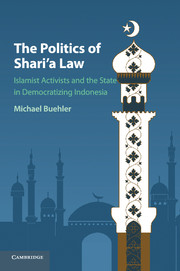Book contents
- The Politics of Shari’a Law
- The Politics of Shari’a Law
- Copyright page
- Contents
- Acknowledgments
- Abbreviations
- Introduction
- 1 State Elites and the Influence of Islamist Activists
- 2 Islamist Activism and the State 1945–1998
- 3 State Elites and Institutional Change
- 4 The Accumulation of Power in Local Politics after 1998
- 5 Islamist Parties after 1998
- 6 Islamist Movements after 1998
- 7 Providing Resources in Exchange for Shari’a Regulations
- 8 Conclusion
- Book part
- Bibliography
- Index
- References
Bibliography
Published online by Cambridge University Press: 05 August 2016
- The Politics of Shari’a Law
- The Politics of Shari’a Law
- Copyright page
- Contents
- Acknowledgments
- Abbreviations
- Introduction
- 1 State Elites and the Influence of Islamist Activists
- 2 Islamist Activism and the State 1945–1998
- 3 State Elites and Institutional Change
- 4 The Accumulation of Power in Local Politics after 1998
- 5 Islamist Parties after 1998
- 6 Islamist Movements after 1998
- 7 Providing Resources in Exchange for Shari’a Regulations
- 8 Conclusion
- Book part
- Bibliography
- Index
- References
- Type
- Chapter
- Information
- The Politics of Shari'a LawIslamist Activists and the State in Democratizing Indonesia, pp. 232 - 258Publisher: Cambridge University PressPrint publication year: 2016



